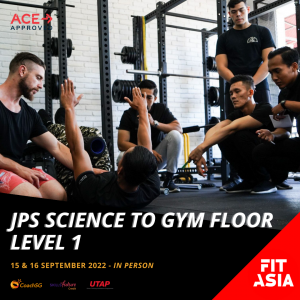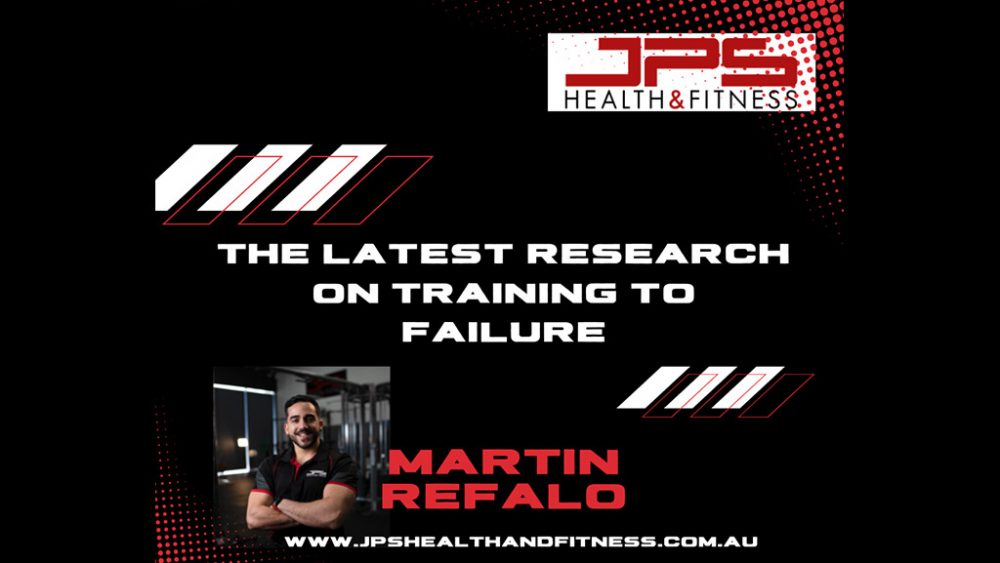

Training to “failure” has always been a hot topic in the fitness industry, with many diverging opinions and ideas that can make it hard to clarify how one should approach their training. For this reason, one of the goals of my PhD research is to help elucidate the influence of “proximity-to-failure” on muscle hypertrophy.
In this article, I summarise some of the key points from my recently published scoping review, co-authored by Dr. Eric Helms, Dr. Jackson Fyfe, and Dr. Lee Hamilton, and titled “Towards an improved understanding of proximity-to-failure in resistance training and its influence on skeletal muscle hypertrophy, neuromuscular fatigue, muscle damage, and perceived discomfort: A scoping review”, to provide you a with a comprehensive overview of the relevant literature; both in regard to key findings and methodological limitations. Keep in mind, a scoping review is not as conclusive in nature as a systematic review, or meta-analysis, and is rather aimed at simply “providing a robust and transparent overview of the literature whilst identifying research gaps”.
Our research question
To better understand exactly what we set out to do with this review, here were the primary objectives:
- Summarise key definitions for set failure in RT used throughout the literature.
- Discuss methods for controlling (or determining) proximity-to-failure in non-failure resistance training.
- Review current evidence for the role of proximity-to-failure on muscle hypertrophy and short-term responses (i.e., neuromuscular fatigue, muscle damage, and perceived discomfort) to resistance training.
As such, our research question was as follows: “How does resistance training proximity-to-failure influence skeletal muscle hypertrophy, neuromuscular fatigue, muscle damage, and perceived discomfort (or affective responses), and what are the key methodological considerations for interpreting the findings of the literature and the gaps to be addressed in future research?”
Background information
Here are some key points from the introduction of the scoping review that will explain why we were not only interested in the influence of proximity-to-failure on muscle hypertrophy, but also on short-term responses to resistance training, namely neuromuscular fatigue, muscle damage, and perceived discomfort.
- Proximity-to-failure may influence higher threshold motor unit recruitment throughout a set and type II muscle fibre activation, both potentially important factors for muscle hypertrophy.
- Short-term responses like neuromuscular fatigue and muscle damage seem to be influenced by proximity-to-failure and may impair contractile function during and subsequent to resistance training.
- Perceived discomfort experienced during a set and immediately after a set also seems to be influenced by proximity-to-failure.
- Short-term responses may impair one’s ability to apply sufficient mechanical tension to promote muscle hypertrophy over time via their influence on post-RT recovery and subsequent RT performance, as well as potentially long-term adherence to RT.
What we did
Of course, to explore the topic at hand and answer the research question, we had to collate and evaluate all relevant the peer-reviewed studies. Mind you, this wasn’t as easy as running a google search or two! For those who aren’t aware, a scoping review still involves a systematic search to identify all relevant studies (like a systematic review or meta-analysis) within the available literature and to eliminate any “selection bias” from the process. You could imagine how an authors’ bias may affect the retrieval of studies if a systematic search was absent, and to give you an idea of how our search was conducted, I created the following flow chart that depicts how over 1000 studies were initially retrieved but eventually distilled down to 38 studies categorised into separate themes.
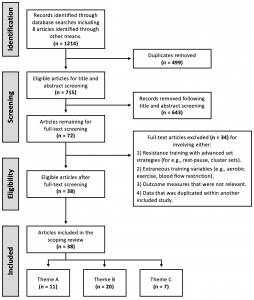
If you want to know more about the exact studies retrieved, along with important study characteristics and key findings, check out the tables I created that include all the relevant information here: https://osf.io/y4g8v/
Importantly, depending on the specific definition of set failure used (and therefore the research question being examined), each included study was grouped into one of three themes to improve the validity of study comparisons and interpretations within each theme. For example, Theme A involves studies that compared resistance training performed to momentary muscular failure versus non-failure resistance training, whereas Theme B compared set failure (defined as anything other than the definition of momentary muscular failure) with non-failure. Contrastingly, Theme C involved studies that compared different proximities-to-failure (i.e., applying different velocity-loss thresholds that modulate set termination and albeit indirectly, influence proximity-to-failure), with no inclusion of a group performing RT to momentary muscular failure per se.
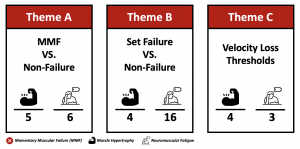
Definitions of “failure”
Grouping the studies into themes was a critical aspect of our scoping review, as previous research seems to dismiss the variability that is present amongst studies that investigate proximity-to-failure. We discussed this in the introduction to the scoping review, stating that “A key barrier to further understanding of the influence of proximity-to-failure on RT adaptations is that no consensus definition for “failure” exists in the literature…For example, participants in the set failure condition in some studies perform RT to volitional failure [13, 14] or to a repetition-maximum (RM) [15, 16], both of which can influence the proximity-to-failure achieved upon set termination as they are dependent on either one’s subjective experience or a predetermined repetition prescription, respectively”. We also go on to state that applying the definition of momentary muscular failure is the most objective way to control set termination, as it involves an involuntary set termination. When understanding the variability in definitions of set failure applied across the literature, it is clear that previous “meta-analyses assessing the effect of “failure” on physiological adaptations have compared studies applying various definitions of set failure, potentially confounding the conclusions drawn [17-19]”.
See here for different definitions of “failure”:

Control of proximity-to-failure
Not only are there issues with the definitions of failure used throughout the literature, but the control of proximity-to-failure within non-failure conditions also has its limitations. As mentioned in the scoping review, “the set termination prescription used for a non-failure condition can influence the absolute difference in the proximity-to-failure between set failure and non-failure conditions in any given study, which likely influences conclusions on the influence of proximity-to-failure on outcome measures”.
For example, if studies use a predetermined repetitions prescription for set termination, it is likely that the proximity-to-failure achieved could change from set-to-set and may be different between participants. If you and I both had to terminate a set once we reached eight reps, and we were both using 75% of our 1-RM – but you could do 15 reps to momentary muscular failure with that given load and I could only do 10 – the proximity-to-failure we would achieve upon set termination would be different. This would also be the case if we were terminating our sets based on velocity loss, whereby sets are performed until the lifting velocity decreases by a specific percentage of the velocity achieved on the first repetition, which is a common set termination method used in studies that indirectly compare different proximities-to-failure. As such, the proximities-to-failure achieved in non-failure conditions can’t be accurately translated to RIR values, limiting our ability to draw practical recommendations.
See below for the most commonly used set termination prescriptions in research:
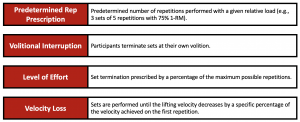
Influence of proximity-to-failure on muscle hypertrophy
Current literature seems to suggest that resistance training performed to momentary muscular failure is not superior to non-failure resistance training for muscle hypertrophy, and that achieving a closer proximity-to-failure does not always promote greater muscle hypertrophy. However, it is unclear how far from momentary muscular failure RT sets should be terminated to theoretically maximise muscle hypertrophy, and this is “likely due to the variability and ambiguity in the RIR achieved amongst non-failure conditions throughout the literature, the inability to translate the magnitude of velocity loss during RT to specific RIR values, and the difficulty in interpreting research that uses velocity loss thresholds due to between-group differences in volume-load”.
See the below summary of key findings from each theme as it pertains to muscle hypertrophy:
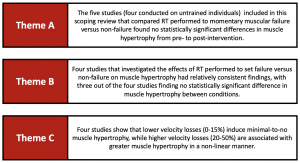
Influence of proximity-to-failure on short-term responses to resistance training
Regarding short-term responses to resistance training, it seems that proximity-to-failure is a primary driver of alterations in neuromuscular function, with acute and delayed neuromuscular fatigue observed to a) increase as proximity-to-failure nears, and b) be greatest when momentary muscular failure is reached. The influence of proximity-to-failure on long-term neuromuscular fatigue accumulation is unclear, however, as only one study involved a longer-term intervention (10 weeks). As mentioned in the scoping review, “the possibility remains that neuromuscular fatigue accumulates in the long-term, exacerbating the impact on post-RT recovery and subsequent RT performance, whilst potentially hindering physiological adaptations to RT. In contrast, it is also possible that the effect of proximity-to-failure on muscle damage is attenuated with repeated bouts of RT, a phenomenon known as the “repeated-bout effect” [82]”.
See the below summary of key findings from each theme as it pertains to short-term responses to resistance training:
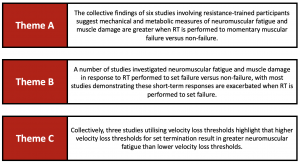
One of the major limitations of this body of research was that numerous studies required set termination to occur once 50% of the maximal possible reps was complete, as such, it is unclear how performing resistance training closer to set failure would influence study findings. Indeed, the primary aim of my current experimental research (currently being conducted) is to investigate the effect of different proximities-to-failure on neuromuscular fatigue with an RIR-based approach following thorough familiarisation to improve the validity of study findings.
Summary of key findings
Based on the above findings, we concluded that “…research suggests that for both untrained and resistance-trained individuals, performing RT to set failure is likely not superior to non-failure RT to promote muscle hypertrophy, but the optimal proximity to failure for muscle hypertrophy remains unclear, and may be moderated by other RT variables (e.g., load, volume-load, number of sets, exercise selection). Performing RT to set failure also induces greater neuromuscular fatigue and muscle damage (lasting up to 48-hours post-RT), and greater post-set perceived discomfort, than non-failure RT. Increasing the time-course for recovery of neuromuscular function post-RT could limit the volume and/or frequency of subsequent RT, and higher ratings of perceived discomfort may negatively influence long-term adherence to RT, both of which may negatively impact long-term muscle hypertrophy responses”.
What are the practical applications?
The review also consisted of a practical applications section, where we made it clear that the findings of the review should not be interpreted as to dismiss the potential utility of performing resistance training to momentary muscular failure in some circumstances, and that the prescription of resistance training should not be treated dichotomously. Rather, it is likely that a range of proximities-to-failure, along with momentary muscular failure, can be utilised to promote muscle hypertrophy. It is also judicious to consider the relationship between proximity-to-failure and neuromuscular fatigue, to limit intra-session neuromuscular fatigue, and to ensure that post-exercise recovery is not impeded to an extent that negatively effects subsequent RT sessions.
It is recommended that the prescription of proximity-to-failure in RT is dependent on:
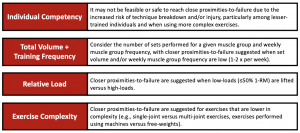
Further, we also suggest that individuals have a sufficient ability to subjectively predict RIR during a given set when momentary muscular failure is not the target. This would allow for resistance training to be prescribed to an RIR target with a flexible repetition range (e.g., 3 sets of 10-15 repetitions with 2-RIR) instead of a predetermined repetition target (e.g., 3 sets of 10 repetitions). We argue that “this RIR-based approach to set termination may ensure that a sufficient proximity-to-failure is reached within each given set whilst limiting the degree of intra-session neuromuscular fatigue incurred and, over time, facilitate the accumulation of sufficient volume-load and exposure to mechanical tension required to promote muscle hypertrophy”.
Overall, to improve subjective RIR predictions on a given exercise, it is recommended that “higher-loads (>50% 1-RM) are used versus lower-loads to limit the degree of perceived discomfort experienced and to initiate the set with a closer proximity-to-failure”. Further, “if safe to do so, momentary muscular failure is experienced on a given exercise to improve the individual’s subjective perception of proximity-to-failure. Individuals may also practice indicating when they have reached a RIR target in a given set, before proceeding to reach momentary muscular failure, to inform the accuracy of their RIR prediction”.
And that brings us to the end! I hope that this brief summary of our recently published scoping review provides you with an improved understanding of what current research can tell us about the influence of proximity-to-failure on muscle hypertrophy and short-term responses to resistance training. I also hope that you are able to take away some of the practical recommendations and apply them to your own (or your clients’) training. I look forward to publishing more peer-reviewed research in the near future to provide greater insights into this topic…stay tuned!
Martin is a PhD student, evidence-based coach, educator and university level teacher with an intense passion for the fitness industry and the science behind training and nutrition.
Martin will be teaching Science to Gym Floor Level 1 here at FIT Asia on September 15-16th, alongside his JPS Health and Fitness Colleagues, Jacob and Samuel Schepis.
They will also be presenting at ExPRO 2022 on 17-18 September 2022. Get your tickets now here!






